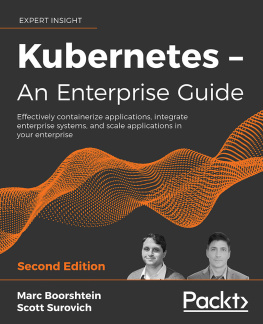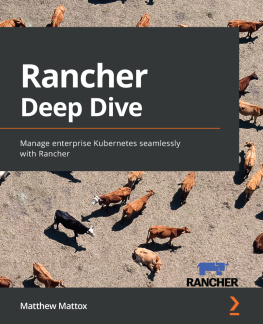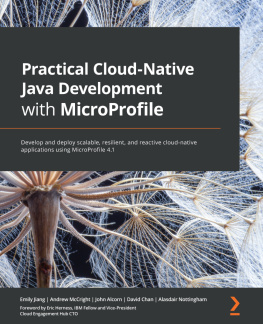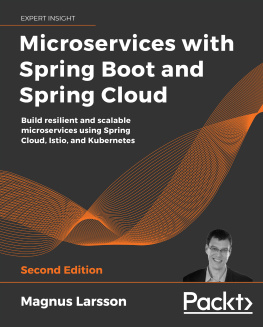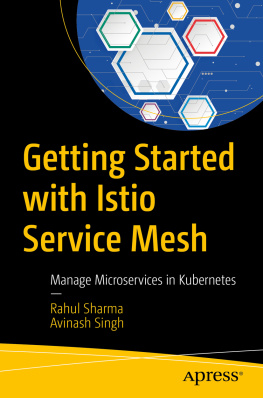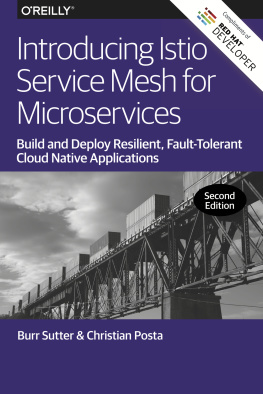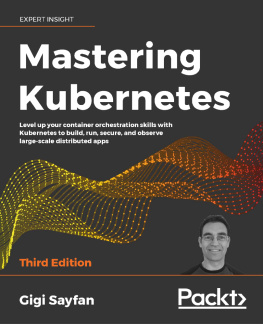Marc Boorshtein - Kubernetes – An Enterprise Guide: Effectively containerize applications, integrate enterprise systems, and scale applications in your enterprise, 2nd Edition
Here you can read online Marc Boorshtein - Kubernetes – An Enterprise Guide: Effectively containerize applications, integrate enterprise systems, and scale applications in your enterprise, 2nd Edition full text of the book (entire story) in english for free. Download pdf and epub, get meaning, cover and reviews about this ebook. year: 2022, publisher: Packt Publishing - ebooks Account, genre: Computer. Description of the work, (preface) as well as reviews are available. Best literature library LitArk.com created for fans of good reading and offers a wide selection of genres:
Romance novel
Science fiction
Adventure
Detective
Science
History
Home and family
Prose
Art
Politics
Computer
Non-fiction
Religion
Business
Children
Humor
Choose a favorite category and find really read worthwhile books. Enjoy immersion in the world of imagination, feel the emotions of the characters or learn something new for yourself, make an fascinating discovery.
- Book:Kubernetes – An Enterprise Guide: Effectively containerize applications, integrate enterprise systems, and scale applications in your enterprise, 2nd Edition
- Author:
- Publisher:Packt Publishing - ebooks Account
- Genre:
- Year:2022
- Rating:3 / 5
- Favourites:Add to favourites
- Your mark:
Kubernetes – An Enterprise Guide: Effectively containerize applications, integrate enterprise systems, and scale applications in your enterprise, 2nd Edition: summary, description and annotation
We offer to read an annotation, description, summary or preface (depends on what the author of the book "Kubernetes – An Enterprise Guide: Effectively containerize applications, integrate enterprise systems, and scale applications in your enterprise, 2nd Edition" wrote himself). If you haven't found the necessary information about the book — write in the comments, we will try to find it.
Master core Kubernetes concepts important to enterprises from security, policy, and management point-of-view. Learn to deploy a service mesh using Istio, build a CI/CD platform, and provide enterprise security to your clusters.
Key Features- Extensively revised edition to cover the latest updates and new releases along with two new chapters to introduce Istio
- Get a firm command of Kubernetes from a dual perspective of an admin as well as a developer
- Understand advanced topics including load balancing, externalDNS, global load balancing, authentication integration, policy, security, auditing, backup, Istio and CI/CD
Kubernetes has taken the world by storm, becoming the standard infrastructure for DevOps teams to develop, test, and run applications. With significant updates in each chapter, this revised edition will help you acquire the knowledge and tools required to integrate Kubernetes clusters in an enterprise environment.
The book introduces you to Docker and Kubernetes fundamentals, including a review of basic Kubernetes objects. Youll get to grips with containerization and understand its core functionalities such as creating ephemeral multinode clusters using KinD. The book has replaced PodSecurityPolicies (PSP) with OPA/Gatekeeper for PSP-like enforcement. Youll integrate your container into a cloud platform and tools including MetalLB, externalDNS, OpenID connect (OIDC), Open Policy Agent (OPA), Falco, and Velero. After learning to deploy your core cluster, youll learn how to deploy Istio and how to deploy both monolithic applications and microservices into your service mesh. Finally, you will discover how to deploy an entire GitOps platform to Kubernetes using continuous integration and continuous delivery (CI/CD).
What you will learn- Create a multinode Kubernetes cluster using KinD
- Implement Ingress, MetalLB, ExternalDNS, and the new sandbox project, K8GBConfigure a cluster OIDC and impersonation
- Deploy a monolithic application in Istio service mesh
- Map enterprise authorization to Kubernetes
- Secure clusters using OPA and GateKeeper
- Enhance auditing using Falco and ECK
- Back up your workload for disaster recovery and cluster migration
- Deploy to a GitOps platform using Tekton, GitLab, and ArgoCD
This book is for anyone interested in DevOps, containerization, and going beyond basic Kubernetes cluster deployments. DevOps engineers, developers, and system administrators looking to enhance their IT career paths will also find this book helpful.
Although some prior experience with Docker and Kubernetes is recommended, this book includes a Kubernetes bootcamp that provides a description of Kubernetes objects to help you if you are new to the topic or need a refresher.
Table of Contents- Docker and Container Essentials
- Deploying Kubernetes using KinD
- Kubernetes Bootcamp
- Services, Load Balancing, and External DNS
- Integrating Authentication into Your Cluster
- RBAC Policies and Auditing
- Deploying a Secured Kubernetes Dashboard
- Extending Security Using Open Policy Agent
- Node Security with Gatekeeper
- Auditing using Falco and EFK
- Backing up Workloads
- Istio Deployment
- Building and Deploying Applications on Istio
- Provisioning a Platform
Marc Boorshtein: author's other books
Who wrote Kubernetes – An Enterprise Guide: Effectively containerize applications, integrate enterprise systems, and scale applications in your enterprise, 2nd Edition? Find out the surname, the name of the author of the book and a list of all author's works by series.

